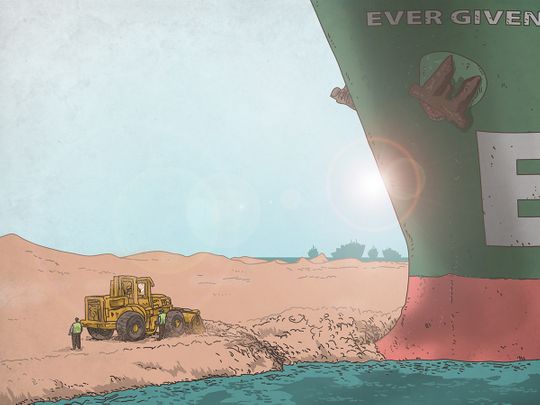
Every Friday, in the last hour of school, the unbridled wonder of my nine-year-old mind was always focused on a big map of the world that dominated one wall of the classroom. There, we would pin different coloured pins with strings as we followed a fleet of Irish ships that were delivering bulk goods around the ports. The Irish Cedar might be picking up wood in the Port of Montreal, down the St. Lawrence; the Irish Rowan shipping iron ore from Brisbane; or the Spruce in transit down the Suez Canal.
It was a weekly exercise that I think whetted my appetite for foreign travel and certainly was a rudimentary introduction to global trade. Come to think of it, the timing likely coincided with the centenary celebrations of the opening of the Suez in 1869, a marvel of engineering that shrank the world and took months off the transit between East and West and eliminated the need to go around the Cape at the bottom of Africa. Tea from Ceylon, cotton from India, spices from the Dutch East Indies — exotic goods moving from the far-flung corners of European empires — and yes, the Suez Canal was an imperial conduit that once dug and fully functional became the key strategic bottleneck in an age where naval power projected might regardless of rights.
The events of this past week has once more focused a lot of thinking on the exact nature of that bottleneck and its critical importance in keeping global commerce moving one vessel at a time. Now, one container upon another, stacked upright by the score and wide by as many too, are shipped in titanic numbers by mighty vessels that, thanks to the misadventures of the good ship Ever Given, we know now are as long as four football stadiums and as tall as a decent vertigo-inducing skyscraper.
It’s hard to fathom that the Ever Given sat so large as it wedged across the Suez that it could be seen from space. And for the hundreds of vessels unable to transit, there was a knock-on effect for consumers the world over. Click-and-collect became wait-and-see for six days straight as tugs and dredgers, engineers and diggers plotted to release the beached vessel. I’m sure that Ferdinand de Lessops, the French diplomat responsible for joining the Mediterranean and Red Seas, would be rolling over in his grave at the sight of the Ever Given stuck in the sand, its bulbous bow gouged into the Sahara, its stern wedged akimbo as the captains of global commerce ordered vessels from ‘full steam ahead’ to weigh anchor or set new headings for Cape Town and beyond.
If ever you should require a definition of globalisation, consider that the Ever Given is owned by a shipping company, Shoei Kisen Kaisha, based in Japan. She — by conventions ships are always female though, given the sheer size and capacity of this boat, it certainly seems to have hermaphroditic properties — was launched in May 2018.
The Ever Given is leased by Ever Green, a container shipping company based in Taiwan who likely now wishes that its name wasn’t writ large in letters 30-metres tall on the port and starboard of each of the 160 vessels in its fleet.
Management of the vessel is actually the responsibility of a marine logistics company based out of Germany, and the MV Ever Given is actually registered in Panama. Most ships today steam under “flags of convenience” — registered to nations such as Panama or Liberia, Bermuda or the Marshall Islands where lax tax rules and labour laws make for smoother sailing for shipping magnates. The Ever Given’s 25 crew members from across South and Southeast Asia — places like India, Pakistan, Bangladesh, the Philippines, Malaysia and Indonesia — where the sweat of sailors keeps global trade afloat.
She was transiting the Suez that is Egyptian owned and operated — the rancour of that nationalisation in the mid-1950s still rankles some and only last month has the United Kingdom restated its international intent of focusing its foreign policy once more on the Indo-Pacific region — and was blown suddenly off course by a Mideast sandstorm. The Ever Green was en route from Malaysia to Rotterdam, then the UK and on to the US. It took a team of Dutch engineers working with Egyptian tugs to finally set her free.
The Ever Given is one of a growing number of mega vessels that transverse the world on a circuit of containerised commerce that satiate our hunger for cheap consumer goods — a global supply chain that operates mostly unnoticed.
When the canal first opened in 1869, it was a channel barely eight metres deep and 22 metres wide at the bottom, and 61 to 91 metres wide at the surface. To allow ships to pass each other, passing bays were built every eight to 10 kilometres and construction involved the excavation and dredging of 74 million cubic metres of sediment. It’s completion was equivalent in today’s world of putting a man on the Moon.
Over the past decade, the canal has been widened and new channels dug — again a source of national pride to the government of President Abdul Fattah Al Sissi, which draws 2 per cent of its annual GDP from canal revenues. Certainly the events of this past week show the passage is more critical than ever.
On any given day, 12 per cent of global trade is sailing though the canal, so too a million barrels of oil and 8 per cent of the liquefied natural gas. With so much at stake, there will be lawsuits that will take armies of lawyers many years to settle. Those discussions will take place on dry land. Right now, the Ever Given is back voyaging the world’s oceans, the Suez is open again, vessels are sailing, and we can fill up, turn up the thermostat and click-and-collect knowing that is indeed right with the world.








